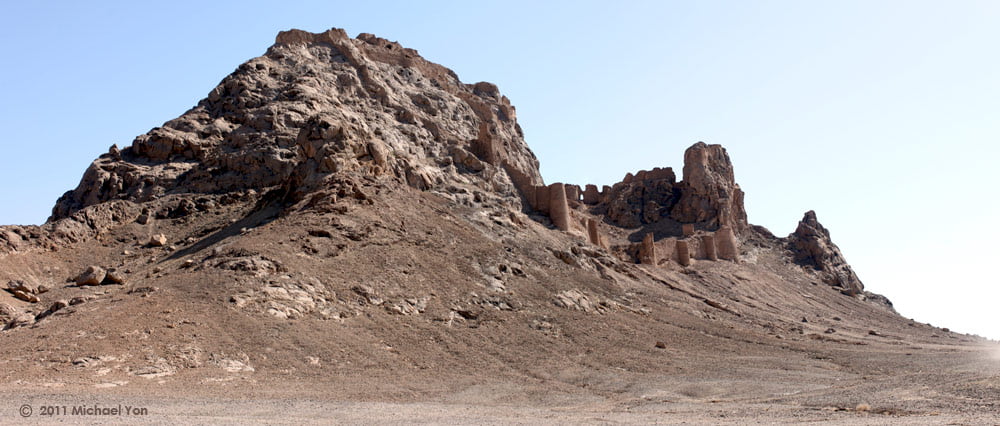 Kak Kohzad 32° 16.636’N, 62° 10.955’E
Kak Kohzad 32° 16.636’N, 62° 10.955’E
Pre-Islamic Afghanistan was, in different eras, home to major belief systems including Zoroastrianism, Hinduism, Buddhism, maybe a bit of Judaism, and many other less known theologies. Over long stretches of history, minor religions or cults come and go like summer storms. Only the most severe leave evidence of impact. Alexander was a Greek polytheist on the march. He brought large pieces of the advanced culture of Classical Greece with him, which laid a cultural base whose influences can still be seen. Next came Buddhists from the east, whose culture mingled with the Greek to form a unique entity known as Gandharan Buddhism. The Scrolls from Gandhara are possibly the oldest Buddhist writings discovered. The inscriptions on birch bark were preserved inside one of a set of clay pots, probably from eastern Afghanistan or Pakistan. The Ancient Buddhist Scrolls from Gandhara have fascinated scholars and are believed to be about 2,000 years-old.
A thousand or so years after Alexander, in the 7th century, Muslims coming through Persia began the Islamic conquest of Afghanistan. The ‘convert to Islam or die’ dictum proved as effective there as elsewhere.
And so the current major religion of the region is Islam in various manifestations. Kafir means infidel, and whatever Kak Kohzad may have been called previously, Afghans call it Kafir Qala: Fort of the Infidels. There are other ‘Kafir Qalas’ in the region, and so during conversation one must ascertain location to avoid confusion.
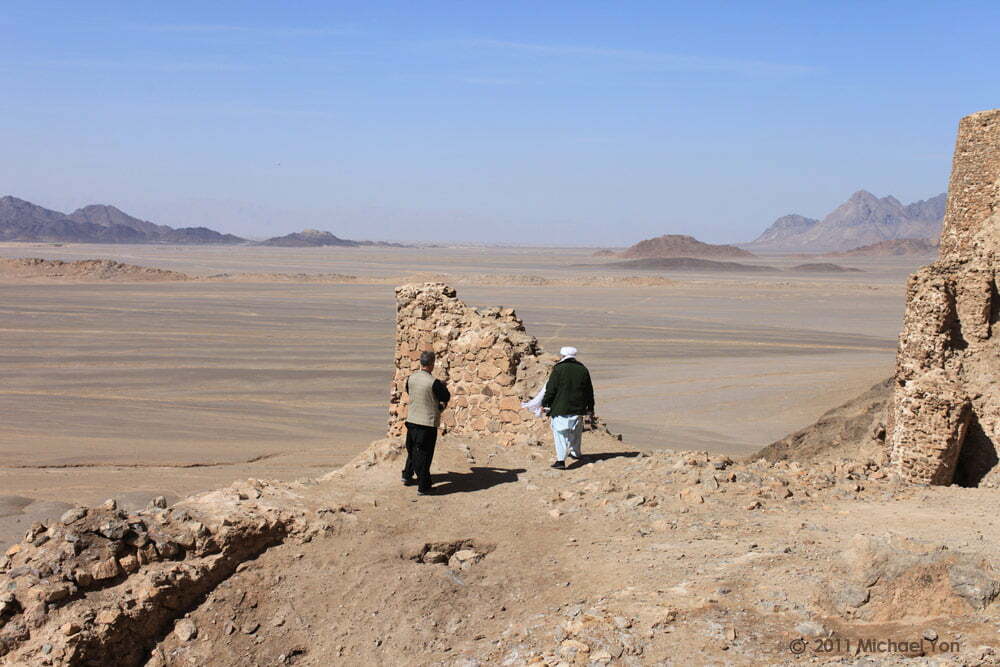 Kris and Afghan man standing where I made the Middle GigaPan using the robot.
Kris and Afghan man standing where I made the Middle GigaPan using the robot.
Though we would not discover the origins or solve the mysteries of Kafir Qala, we could, in one afternoon, create a significant photographic record of part of the structure. This large image was made from the western bottom of bottom of Kafir Qala using the Gigapan robot.
Up on the steep slope, I made several more images using the robot, including this 360° Middle GigaPan.
The mysterious well is about 20 feet higher than the vantage point from which I took the pictures. Both my Trackstick and Google Earth were unable to show a precise location, but a close guess is that the well is at about 2,490 feet above sea level, while the free flowing river is about 400 feet lower and nearly ten miles away. Why would someone dig a well so far up the hill? That was part of the mystery we hoped to answer.
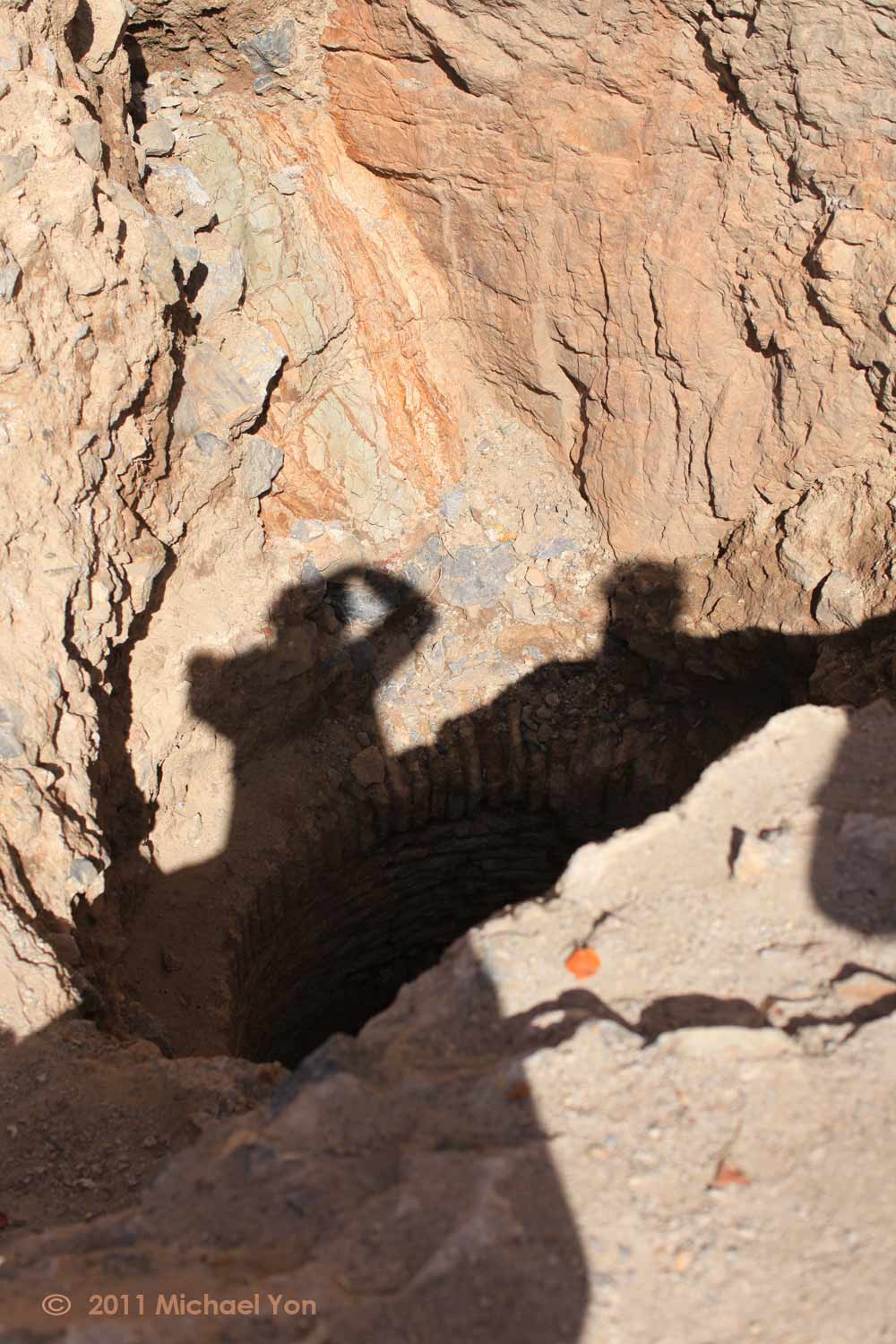 Mystery of Kafir Qala.
Mystery of Kafir Qala.
The well
Looking through the mind’s eye, one can imagine small men and boys climbing down platforms, and within a minute the shaft is dark even during noonday sun. The sun is never directly over Afghanistan. Kak Kohzad is slightly north of 32°N while the farthest north the sun comes directly over is at about 23.5°N, at the Tropic of Cancer, and even there the sun will only be directly overhead for a few minutes on a single day in June. The only sunlight they could get down in the well would be reflected and faint, especially with the low normal reflectance of this soil. Maybe they used candles, which the Egyptians probably were using 3,000 years before the time of Alexander.
Kris would later say this is the best-constructed well he has seen in Afghanistan. Having seen many wells myself, I concur. The deepest hand-dug well on record is the Woodingdean Well in the UK, excavated over a four-year period using candlelight in the 19th century. The men dug down to an amazing 1,285 feet, and when they finally hit water it suddenly began gushing and flooding the shaft.
Man has a curious habit of throwing people into wells. One never has to look far to find the latest story of villagers being hurtled into their own dark drinking water, whether in the name of war, witchcraft, or crime. A thousand hefty phone books likely would not suffice to list the names of those who’ve plummeted into the hell of a dark well. “Well-tossing” remains alive and “well” today.
India steadily creates well-tossing stories:
Four Children Thrown into Well
“In a dastardly incident, four innocent children were thrown into well and bombarded with huge stones by unknown assailants. Out of the four, three succumbed to injuries while fourth is in serious condition. The motive was to take revenge from the father of the kids Dhirendra. The criminals also reportedly beat the children before being dumped into the well. The killers also took out the eyes of one of the children.”
Sometimes it’s done to poison the well, while other times it seems to be done for sport, savage pleasure, body disposal, genocide, or to launch a witch into the Earth.
There are more stories of well tossing than one man can read.
“CLEANSE the village of cow-eaters. Remove all Muslims. Chase them and kill them,” the loudspeaker blared out this grim message in Pandharvada village in Panchmahal, where the Vishwa Hindu Parishad was holding a public meeting. Personnel of the local police and a district official, who were present there, sat on the sidelines, drinking tea or talking, and soaking in the atmosphere. Pandharvada’s Muslims stayed away, fearing the worst. Three weeks later, VHP supporters carried out their threat…”
“…in Panchmahal district 11 people died after they were thrown into a well. Four of them were children. Maksooda and Hanif Rahim lost their children, aged two and three years, in the attack. The children were thrown into the well along with Maksooda by the members of the mob that attacked the village’s Muslim basti. “People came from other villages and started burning our houses. We all ran, but some of us were caught and thrown into the well,” says Maksooda, who was the only one rescued from the well by the police. The rest were already dead…”
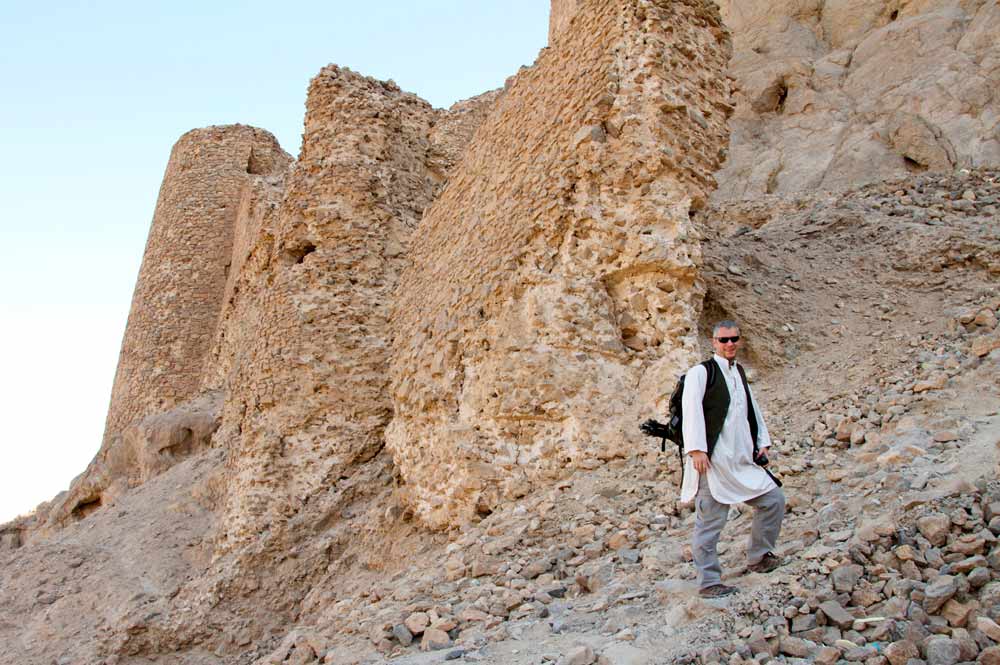 Matthew Goldthwaite climbing Kak Kohzad, aka Kafir Qala.
Matthew Goldthwaite climbing Kak Kohzad, aka Kafir Qala.
And so, in 2010, Steve Shaulis aimed to plumb the depths. If human remains were found, he’d have the bones pulled out and handed over to local Afghans for proper burial.
There was the mystery of why the well was dug so high on the hill. Eight miles away, Alexander had put his massive Citadel near the river so the water needs of his Army of men and animals would be satisfied. That is logical. Kak Kohzad is a military fort, not a summer house. Why hadn’t the builders of Kak Kohzad made the same decision? Looking at the ruins, clearly they were very smart people.
I stood by the well, within the Citadel’s crumbling walls, looking at the terrain below, imagining how to attack this place with the intention of capturing it. Why would anyone commit forces to storm the fortress, uphill, incurring high casualties, if you could more easily blockade a water source closer to ground level? A blockade would force the defending commander in Kak Kohzad to expend his own men to get to the water. A wall is never stronger than the people defending it. Without water, defense of the fort was unsustainable. A water source within the Citadel walls would be the beating heart of sustained defense.
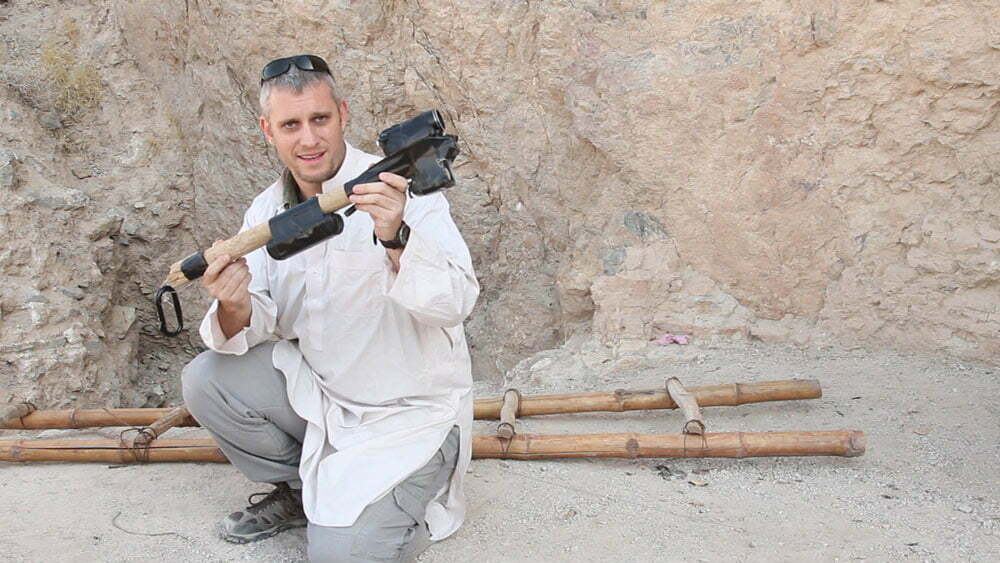 Matt holding Kris’s camera contraption.
Matt holding Kris’s camera contraption.
Matt Goldthwaite would later write to me:
“In [February] 2010, I went to the citadel of the infidel with the Afghan contracting officer for USAid from Kabul. While there he told me that the site is rife with folklore, among which, that the fort was under siege for 50 years and the large boulders at the base were thrown down at the invading army from the citadel. According to the legend, the well was dug during the siege as a combo source of water and escape route. Furthermore, the legend says that the king left his treasure, (this is why the Afghan Minister of Cultural Affairs and Antiquities sent a rep, just in case we found something [during the November 2010 trip]). When you look at the well, if you look up to the top, you will see a level at the very top of the mountain. This was alleged to be where the kings lived. I am attaching some photos I took from the very top of the citadel. Anywhere else in the world this place would be a world heritage site, but in AFG we can climb and explore and live out my childhood dream of being Indiana Jones.”
Indeed, it is amazing to think that buried down there and well preserved might be writings older than The Scrolls from Gandhara.
And so in November 2010, Matt and Kris flew from Singapore to Dubai to Kandahar, boarded one of Steve’s airplanes and flew to Farah, then drove to Kak Kohzad, and trudged up the hill to get to the bottom of it. Matt and Kris were joined by a representative of the Afghan Minister of Cultural Affairs and Antiquities, and a small police security detachment.
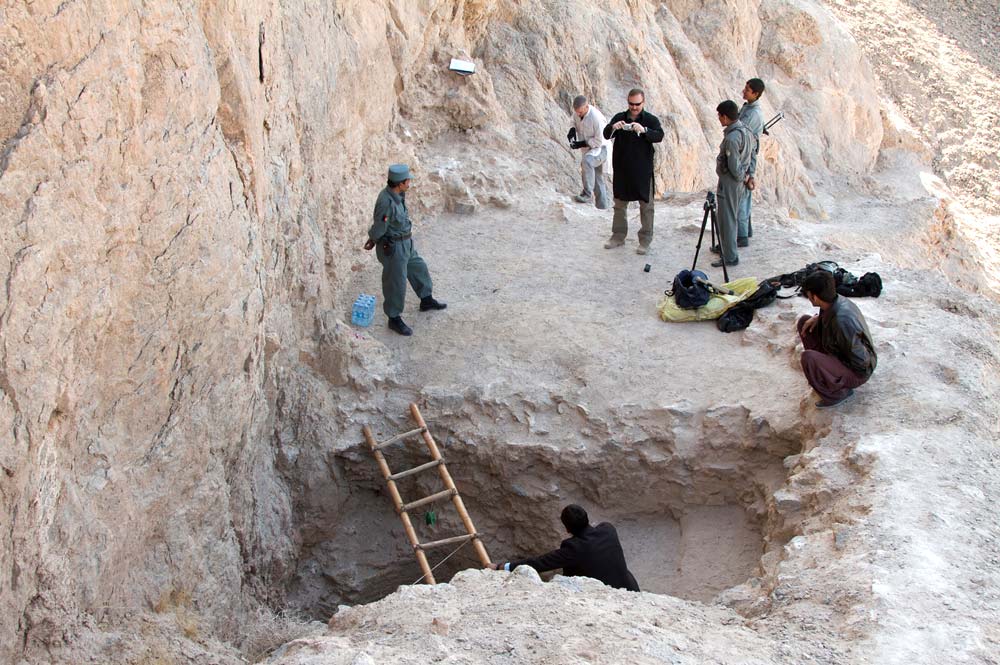 This is cool stuff!
This is cool stuff!
They didn’t want to send someone down the well without reconnaissance, so Kris rigged a clever camera contraption along with an attached light.
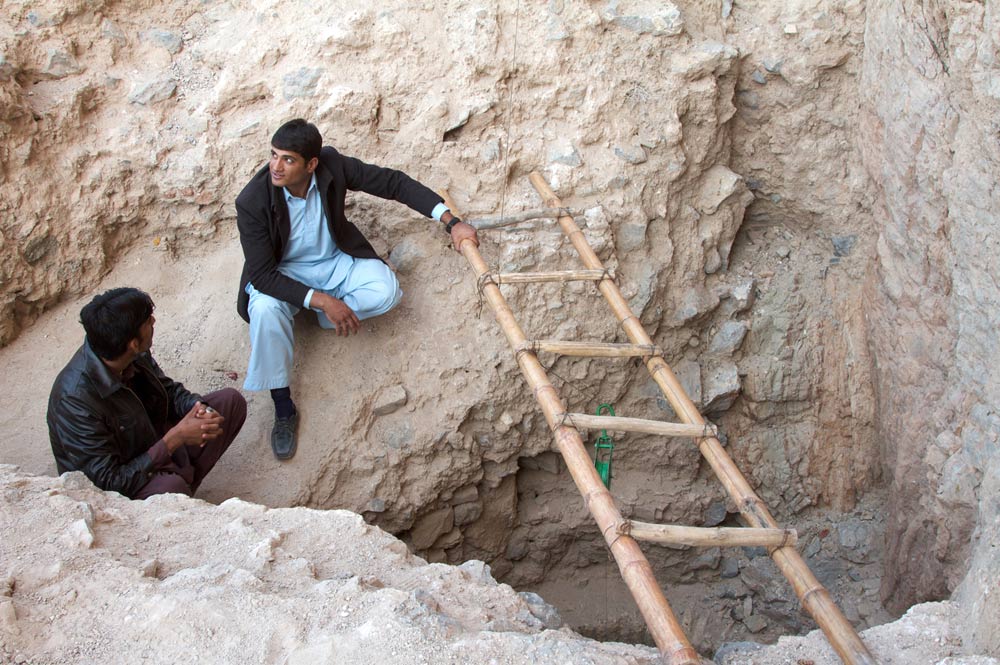 Drum roll…..
Drum roll…..
 Drum rolling…
Drum rolling…
A savvy writer would end the story here.
The End.
(Stay tuned for Part II)




1 Comment
We visited the Siwa Oasis in Egypt ten years ago.
A long journey to a historic place.
Scary driver .. great end to two weeks river trip.
https://shezlikethewind.com/2021/01/09/temple-of-the-oracle-alexander-the-great-siwa-oasis-egypt/